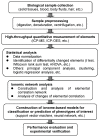Disease Ionomics: Understanding the Role of Ions in Complex Disease
- PMID: 33212764
- PMCID: PMC7697569
- DOI: 10.3390/ijms21228646
Disease Ionomics: Understanding the Role of Ions in Complex Disease
Abstract
Ionomics is a novel multidisciplinary field that uses advanced techniques to investigate the composition and distribution of all minerals and trace elements in a living organism and their variations under diverse physiological and pathological conditions. It involves both high-throughput elemental profiling technologies and bioinformatic methods, providing opportunities to study the molecular mechanism underlying the metabolism, homeostasis, and cross-talk of these elements. While much effort has been made in exploring the ionomic traits relating to plant physiology and nutrition, the use of ionomics in the research of serious diseases is still in progress. In recent years, a number of ionomic studies have been carried out for a variety of complex diseases, which offer theoretical and practical insights into the etiology, early diagnosis, prognosis, and therapy of them. This review aims to give an overview of recent applications of ionomics in the study of complex diseases and discuss the latest advances and future trends in this area. Overall, disease ionomics may provide substantial information for systematic understanding of the properties of the elements and the dynamic network of elements involved in the onset and development of diseases.
Keywords: ICP-MS; bioinformatics; complex disease; ionome; ionomics.
Conflict of interest statement
The authors declare no conflict of interest. The funders had no role in the design of the study; in the collection, analyses, or interpretation of data; in the writing of the manuscript, or in the decision to publish the results.
Figures
Similar articles
-
Recent advances in the application of ionomics in metabolic diseases.Front Nutr. 2023 Jan 16;9:1111933. doi: 10.3389/fnut.2022.1111933. eCollection 2022. Front Nutr. 2023. PMID: 36726817 Free PMC article. Review.
-
Recent advancements in the application of multi-elemental profiling and ionomics in cardiovascular diseases.J Trace Elem Med Biol. 2025 Apr;88:127616. doi: 10.1016/j.jtemb.2025.127616. Epub 2025 Feb 7. J Trace Elem Med Biol. 2025. PMID: 39933207 Review.
-
Ionomics and the study of the plant ionome.Annu Rev Plant Biol. 2008;59:709-33. doi: 10.1146/annurev.arplant.59.032607.092942. Annu Rev Plant Biol. 2008. PMID: 18251712 Review.
-
[Progress on ionomics of complex diseases].Sheng Li Xue Bao. 2018 Aug 25;70(4):413-423. Sheng Li Xue Bao. 2018. PMID: 30112567 Review. Chinese.
-
Plant Ionomics: From Elemental Profiling to Environmental Adaptation.Mol Plant. 2016 Jun 6;9(6):787-97. doi: 10.1016/j.molp.2016.05.003. Epub 2016 May 19. Mol Plant. 2016. PMID: 27212388 Review.
Cited by
-
Metal ions and nanometallic materials in antitumor immunity: Function, application, and perspective.J Nanobiotechnology. 2023 Jan 19;21(1):20. doi: 10.1186/s12951-023-01771-z. J Nanobiotechnology. 2023. PMID: 36658649 Free PMC article. Review.
-
Ionomics-metabolome association analysis as a new approach to the impact of dietary copper levels in suckling piglets model.Sci Rep. 2023 Jan 20;13(1):1164. doi: 10.1038/s41598-023-28503-5. Sci Rep. 2023. PMID: 36670179 Free PMC article.
-
Metal Profiles in Autism Spectrum Disorders: A Crosstalk between Toxic and Essential Metals.Int J Mol Sci. 2022 Dec 24;24(1):308. doi: 10.3390/ijms24010308. Int J Mol Sci. 2022. PMID: 36613749 Free PMC article. Review.
-
Recent advances in the application of ionomics in metabolic diseases.Front Nutr. 2023 Jan 16;9:1111933. doi: 10.3389/fnut.2022.1111933. eCollection 2022. Front Nutr. 2023. PMID: 36726817 Free PMC article. Review.
-
Comparing Ionic Profile of Gingival Crevicular Fluid and Saliva as Distinctive Signature of Severe Periodontitis.Biomedicines. 2022 Mar 17;10(3):687. doi: 10.3390/biomedicines10030687. Biomedicines. 2022. PMID: 35327490 Free PMC article.
References
-
- Xiu Y.M. Trace elements in health and diseases. Biomed. Environ. Sci. 1996;9:130–136. - PubMed
Publication types
MeSH terms
Substances
Grants and funding
- 31771407/National Natural Science Foundation of China
- 2019A1515011938/Guangdong Basic and Applied Basic Research Foundation
- JCYJ20180305124023495/Science and Technology Innovation Committee of Shenzhen Municipality
- 2019SHIBS0003/Shenzhen-Hong Kong Institute of Brain Science-Shenzhen Fundamental Research Institutions
LinkOut - more resources
Full Text Sources


